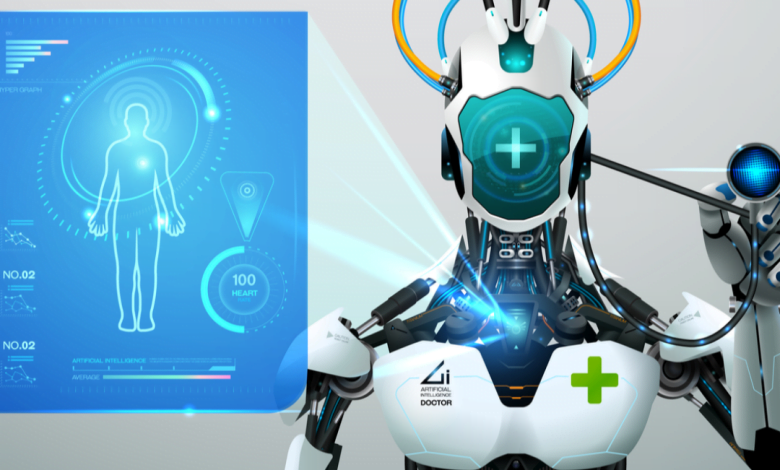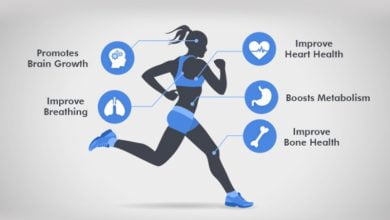Revolutionizing Health and Fitness: An In-Depth Look at Robotics, AI, and Health and Fitness
The Role of Robotics and AI in Transforming Healthcare

Introduction:
In recent years, the fields of robotics and artificial intelligence (AI) have made significant strides in revolutionizing various aspects of healthcare, including diagnostics, treatment, rehabilitation, and fitness. The integration of robotics and AI technologies holds immense potential for improving patient outcomes, enhancing efficiency, and transforming traditional healthcare paradigms. This comprehensive exploration delves into the applications, benefits, challenges, and future prospects of robotics and AI in the realm of health and fitness, highlighting their transformative impact on healthcare delivery and wellness promotion.
Applications of Robotics and AI in Health and Fitness:
The applications of robotics and AI in health and fitness are diverse and encompass a wide range of areas, including:
Medical Imaging and Diagnostics:
AI-powered imaging technologies, such as computerized tomography (CT), magnetic resonance imaging (MRI), and ultrasound, enable more accurate and efficient diagnosis of medical conditions, including cancer, cardiovascular disease, and neurological disorders. AI algorithms can analyze medical images, detect abnormalities, and assist radiologists in interpreting complex imaging data, leading to earlier detection and improved treatment outcomes.
Surgical Robotics:
Robotic-assisted surgical systems, such as the da Vinci Surgical System, allow surgeons to perform minimally invasive procedures with enhanced precision, dexterity, and control. These robotic platforms enable surgeons to navigate intricate anatomical structures, reduce surgical trauma, and achieve better outcomes for patients undergoing procedures such as prostatectomy, hysterectomy, and cardiac surgery.
Rehabilitation Robotics:
Rehabilitation robotics devices, including exoskeletons, robotic prosthetics, and assistive devices, aid in the rehabilitation of individuals with mobility impairments, musculoskeletal injuries, and neurological disorders. These robotic systems provide personalized therapy, assistive support, and real-time feedback to help patients regain mobility, improve function, and enhance quality of life following injury or illness.
Telemedicine and Remote Monitoring:
AI-powered telemedicine platforms and remote monitoring systems enable healthcare providers to deliver virtual care, monitor patients remotely, and manage chronic conditions from a distance. These technologies facilitate timely access to care, reduce healthcare disparities, and empower patients to actively participate in their own health management, particularly in underserved or rural areas with limited access to healthcare services.
Health and Fitness Tracking:
Wearable devices, such as fitness trackers, smartwatches, and biosensors, leverage AI algorithms to monitor vital signs, track physical activity, and analyze health metrics in real time. These devices provide users with personalized insights, feedback, and recommendations for optimizing their health and fitness goals, including exercise routines, sleep patterns, and stress management techniques.
Benefits of Robotics and AI in Health and Fitness:
The integration of robotics and AI technologies in health and fitness offers numerous benefits for patients, healthcare providers, and society as a whole, including:
Improved Patient Outcomes:
Robotics and AI technologies enable earlier detection, more accurate diagnosis, and personalized treatment approaches, leading to improved patient outcomes, reduced complications, and enhanced quality of life for individuals with medical conditions and disabilities.
Enhanced Efficiency and Productivity:
Automation of repetitive tasks, data analysis, and decision-making processes streamlines healthcare workflows, reduces administrative burdens, and enhances efficiency for healthcare providers, allowing them to focus on delivering high-quality, patient-centered care.
Cost Savings and Resource Optimization:
Robotics and AI technologies have the potential to lower healthcare costs, reduce hospital readmissions, and optimize resource utilization by preventing unnecessary procedures, minimizing medication errors, and improving care coordination across the continuum of care.
Accessibility and Equity:
Telemedicine and remote monitoring technologies expand access to healthcare services, particularly for individuals in rural or underserved areas, by overcoming geographical barriers and enhancing care delivery options. These technologies promote healthcare equity, reduce disparities, and ensure that all individuals have access to timely, high-quality care.
Innovation and Personalization:
Robotics and AI foster innovation in healthcare by enabling the development of novel therapies, interventions, and personalized medicine approaches tailored to individual patient needs, preferences, and genetic profiles. These technologies drive advancements in precision medicine, genomic sequencing, and targeted therapies for complex medical conditions.
Challenges and Considerations:
Despite the significant benefits of robotics and AI in health and fitness, several challenges and considerations must be addressed to maximize their potential and mitigate potential risks, including:
Data Privacy and Security:
The collection, storage, and analysis of health data by robotics and AI systems raise concerns about patient privacy, data security, and confidentiality. Safeguarding sensitive health information and ensuring compliance with regulatory requirements are essential considerations in the development and deployment of these technologies.
Ethical and Regulatory Issues:
Ethical considerations, including algorithm bias, accountability, and transparency, pose challenges in the ethical use of AI in healthcare, particularly regarding decision-making processes, patient consent, and data governance. Regulatory frameworks, guidelines, and standards must be established to govern the responsible development and deployment of robotics and AI technologies in healthcare.
Integration and Interoperability:
Integrating robotics and AI systems into existing healthcare infrastructure, electronic health records (EHRs), and clinical workflows requires interoperability standards, data exchange protocols, and seamless integration with existing technologies. Collaboration among stakeholders, including healthcare providers, technology vendors, and policymakers, is essential to overcome interoperability challenges and ensure the effective implementation of these technologies.
Human-Machine Interaction:
Human factors, including user interface design, usability, and acceptance, influence the adoption and usability of robotics and AI technologies in healthcare. Ensuring intuitive user interfaces, training programs, and human-centered design principles are critical to promoting acceptance, adoption, and trust in these technologies among healthcare providers and patients.
Future Directions and Opportunities:
The future of robotics and AI in health and fitness holds immense promise for further advancements, innovations, and transformative impacts on healthcare delivery and wellness promotion. Some future directions and opportunities include:
AI-Powered Drug Discovery and Development:
AI algorithms and machine learning techniques have the potential to revolutionize drug discovery, accelerate pharmaceutical research, and develop novel therapeutics for treating complex diseases, including cancer, neurodegenerative disorders, and infectious diseases.
Predictive Analytics and Precision Medicine:
AI-enabled predictive analytics models can analyze large-scale healthcare data, including genomic data, clinical records, and real-time sensor data, to identify patterns, trends, and predictive biomarkers for disease risk, progression, and treatment response, enabling personalized medicine approaches tailored to individual patient needs.
Robotic-Assisted Rehabilitation and Assistive Technologies:
Advances in robotics and AI technologies will continue to drive innovations in rehabilitation robotics, assistive devices, and mobility aids for individuals with disabilities, enabling personalized therapy, adaptive support, and independent living solutions that enhance mobility, function, and quality of life.
Virtual Reality and Simulation Training:
Virtual reality (VR) and simulation technologies offer immersive training environments, procedural simulations, and medical education platforms for healthcare professionals, enabling experiential learning, skill acquisition, and surgical training in a safe, controlled setting.
Conclusion:
Robotics and AI are transforming the landscape of healthcare delivery and wellness promotion, offering unprecedented opportunities to improve patient outcomes, enhance efficiency, and revolutionize traditional healthcare paradigms. By harnessing the power of robotics and AI technologies, healthcare providers, researchers, and stakeholders can address complex medical challenges, promote preventive care, and empower individuals to achieve optimal health and fitness outcomes. As these technologies continue to evolve, interdisciplinary collaboration, ethical considerations, and patient-centered approaches will be essential in realizing the full potential of robotics and AI in shaping the future of healthcare and wellness.
Title: Harnessing Innovation: Robotics and AI in Health and Fitness
Introduction:
The convergence of robotics and artificial intelligence (AI) has catalyzed a transformative shift in the landscape of healthcare and fitness. With unprecedented advancements in technology, robotics and AI are revolutionizing how we approach diagnostics, treatment, rehabilitation, and wellness promotion. This overview explores the multifaceted role of robotics and AI in health and fitness, elucidating their applications, benefits, challenges, and future prospects in shaping the future of healthcare delivery and personal well-being.
Applications of Robotics and AI in Health and Fitness:
The integration of robotics and AI has led to a myriad of applications across various domains of healthcare and fitness, including:
Medical Imaging and Diagnostics:
AI algorithms analyze medical imaging data with remarkable precision, aiding in the early detection and diagnosis of diseases such as cancer, cardiovascular disorders, and neurological conditions.
Surgical Robotics:
Robotic-assisted surgical systems enhance the capabilities of surgeons, enabling minimally invasive procedures with unparalleled precision and dexterity, leading to faster recovery times and improved patient outcomes.
Rehabilitation Robotics:
Robotics devices facilitate rehabilitation for individuals with mobility impairments, providing personalized therapy and support to improve motor function, enhance mobility, and promote recovery following injury or illness.
Telemedicine and Remote Monitoring:
AI-powered telemedicine platforms and remote monitoring systems enable virtual consultations, remote patient monitoring, and chronic disease management, expanding access to healthcare services and enhancing patient engagement.
Health and Fitness Tracking:
Wearable devices equipped with AI algorithms monitor vital signs, track physical activity, and analyze health metrics, empowering individuals to monitor their health, track fitness goals, and make informed lifestyle choices.
Benefits of Robotics and AI in Health and Fitness:
The integration of robotics and AI brings forth a multitude of benefits for individuals, healthcare providers, and society at large, including:
Improved Patient Outcomes:
Robotics and AI technologies enable early detection, accurate diagnosis, and personalized treatment approaches, leading to improved patient outcomes and enhanced quality of life.
Enhanced Efficiency and Productivity:
Automation of healthcare workflows, data analysis, and decision-making processes streamlines operations, reduces administrative burdens, and enhances efficiency for healthcare providers, enabling them to deliver higher-quality care.
Cost Savings and Resource Optimization:
Robotics and AI technologies optimize resource utilization, reduce healthcare costs, and prevent medical errors, resulting in cost savings for healthcare systems and improved allocation of resources.
Accessibility and Equity:
Telemedicine and remote monitoring technologies overcome geographical barriers, expanding access to healthcare services and reducing healthcare disparities, particularly in underserved or rural areas.
Innovation and Personalization:
Robotics and AI foster innovation in healthcare, driving advancements in precision medicine, personalized therapies, and targeted interventions tailored to individual patient needs and preferences.
Challenges and Considerations:
Despite the promising benefits, the integration of robotics and AI in health and fitness presents several challenges and considerations, including:
Data Privacy and Security:
The collection, storage, and analysis of healthcare data raise concerns about patient privacy, data security, and confidentiality, necessitating robust data protection measures and compliance with regulatory requirements.
Ethical and Regulatory Issues:
Ethical considerations, algorithm bias, and accountability pose challenges in the ethical use of AI in healthcare, requiring the establishment of regulatory frameworks and guidelines to govern responsible AI deployment.
Integration and Interoperability:
Integration of robotics and AI systems into existing healthcare infrastructure and clinical workflows requires interoperability standards, data exchange protocols, and seamless integration with existing technologies.
Human-Machine Interaction:
User interface design, usability, and acceptance influence the adoption and usability of robotics and AI technologies in healthcare, highlighting the importance of human-centered design principles and training programs.
Future Directions and Opportunities:
Looking ahead, the future of robotics and AI in health and fitness holds immense promise for further advancements and innovations, including:
AI-Powered Drug Discovery:
AI algorithms accelerate pharmaceutical research, enabling the development of novel therapeutics and precision medicine approaches for complex diseases.
Predictive Analytics and Precision Medicine:
AI-enabled predictive analytics models identify patterns and trends in healthcare data, enabling personalized medicine approaches tailored to individual patient needs and preferences.
Virtual Reality and Simulation Training:
Virtual reality and simulation technologies provide immersive training environments for healthcare professionals, enhancing experiential learning and surgical training in a safe, controlled setting.
Conclusion:
The integration of robotics and AI is revolutionizing healthcare delivery and wellness promotion, offering unprecedented opportunities to improve patient outcomes, enhance efficiency, and transform traditional healthcare paradigms. By harnessing the power of robotics and AI technologies, stakeholders can address complex medical challenges, promote preventive care, and empower individuals to achieve optimal health and fitness outcomes. As these technologies continue to evolve, interdisciplinary collaboration, ethical considerations, and human-centered approaches will be essential in realizing their full potential in shaping the future of healthcare and personal well-being.
Introduction to Robotics and AI in the Health and Fitness Industry
In today’s rapidly evolving world, the fields of robotics and artificial intelligence (AI) are making significant contributions to various industries. One such sector that is experiencing a revolution is health and fitness. The integration of robotics and AI in healthcare has opened up new possibilities for improving patient care, medical diagnosis, treatment, and even fitness and wellness. In this article, we will delve into the fascinating world of robotics and AI in the health and fitness industry, exploring their applications, advancements, challenges, and future prospects.
Understanding Robotics: Definition and Application in Healthcare
Robotics, in simple terms, refers to the design, development, and application of robots. In the context of healthcare, robotics involves the use of robotic systems to assist in medical procedures, surgeries, and rehabilitation. These systems are designed to perform tasks with precision, accuracy, and often with greater efficiency than human counterparts. From surgical robots that aid in minimally invasive procedures to robotic exoskeletons that assist in physical therapy, robotics is transforming the way healthcare is delivered.One of the key advantages of robotics in healthcare is the ability to perform complex tasks with minimal risk. For instance, robotic surgery allows for smaller incisions, reduced blood loss, and shorter recovery times. Robotic exoskeletons enable individuals with mobility impairments to regain strength, coordination, and independence. Additionally, robots can be utilized for repetitive tasks, allowing healthcare professionals to focus on more complex aspects of patient care.
Exploring Artificial Intelligence (AI) in the Health and Fitness Sector
Artificial intelligence, on the other hand, refers to the simulation of human intelligence in machines. AI systems are designed to analyze data, learn from it, and make decisions or perform tasks autonomously. In the health and fitness sector, AI is employed in a wide range of applications, including medical imaging, drug discovery, personalized medicine, and health monitoring.Medical imaging, such as MRI and CT scans, generates vast amounts of data that can be difficult for human experts to analyze comprehensively. AI algorithms can process and interpret these images, aiding in the early detection and diagnosis of diseases. AI-powered drug discovery platforms are revolutionizing the pharmaceutical industry by accelerating the identification of potential drug candidates. Personalized medicine, which tailors treatments to individual patients, relies on AI to analyze genetic and clinical data to make precise treatment recommendations. AI-powered wearable devices and mobile applications are becoming increasingly popular for health monitoring, allowing individuals to track their fitness levels, heart rate, sleep patterns, and more.
The Role of Robotics and AI in Revolutionizing Patient Care
The integration of robotics and AI in healthcare is transforming patient care in numerous ways. For instance, robotic-assisted surgeries are revolutionizing the field of surgery by providing surgeons with enhanced precision, control, and visualization. With the help of robotic systems, surgeons can perform complex procedures with greater accuracy and minimal invasiveness. This results in reduced pain, faster recovery times, and improved patient outcomes.AI-powered systems are also making significant contributions to patient care. For example, AI algorithms can analyze a patient’s medical history, symptoms, and test results to provide accurate and timely diagnosis. This can help healthcare professionals make informed treatment decisions, leading to improved patient outcomes. AI-powered chatbots and virtual assistants are being used to provide personalized health advice, answer medical queries, and offer emotional support to patients.The synergy of robotics and AI in patient care is not limited to hospitals and clinics. Telemedicine, which involves remote diagnosis and treatment, is being revolutionized by robotics and AI. Robots equipped with cameras, sensors, and AI algorithms can assist healthcare professionals in conducting virtual consultations, remote monitoring of patients, and even performing routine check-ups. This enables individuals in remote or underserved areas to access quality healthcare services, bridging the gap between healthcare providers and patients.
Advancements in Robotics and AI for Medical Diagnosis and Treatment
As robotics and AI continue to advance, the healthcare industry is witnessing remarkable breakthroughs in medical diagnosis and treatment. AI algorithms are being developed to analyze vast amounts of medical data, including electronic health records, medical images, and genomic data. This data-driven approach enables physicians to make more accurate diagnoses, identify patterns and trends in diseases, and develop personalized treatment plans.In the field of radiology, AI algorithms are being trained to analyze medical images and detect abnormalities with high accuracy. This can help radiologists prioritize and interpret images, leading to faster diagnosis and treatment. AI-powered diagnostic tools are also being developed for various diseases, including cancer, cardiovascular disorders, and neurological conditions. These tools can aid in the early detection of diseases, allowing for timely interventions and improved patient outcomes.Robotic systems are also evolving to enhance medical diagnosis and treatment. For example, robotic endoscopes equipped with AI algorithms can navigate the gastrointestinal tract more precisely, enabling early detection of lesions and tumors. Robotic prosthetics are being developed to provide amputees with enhanced mobility and dexterity, improving their quality of life. Moreover, robotics is playing a crucial role in rehabilitation, enabling patients to regain motor control and function through robot-assisted therapy.
Robotics and AI in Fitness and Wellness: Enhancing Performance and Monitoring
While the impact of robotics and AI in patient care is evident, their potential in the realm of fitness and wellness should not be overlooked. In recent years, there has been a surge in the development of AI-powered fitness devices and applications that cater to individuals’ specific needs and goals.Wearable devices, such as fitness trackers and smartwatches, equipped with sensors and AI algorithms, can monitor various aspects of fitness, including heart rate, sleep quality, steps taken, and calories burned. These devices provide real-time feedback, allowing individuals to track their progress, set goals, and make informed decisions about their fitness routines. AI-powered fitness applications can also provide personalized workout plans, nutritional recommendations, and virtual coaching, making fitness more accessible and enjoyable.In addition to personal fitness devices, robotics is also being utilized to enhance athletic performance and rehabilitation. Exoskeletons and robotic prosthetics are being developed to assist athletes in their training and recovery. These devices can provide targeted resistance, assist with precise movements, and aid in rehabilitation after injuries. By leveraging robotics and AI, athletes can optimize their performance, prevent injuries, and achieve their full potential.
Ethical Considerations and Challenges in Robotics and AI Adoption
As with any transformative technology, the adoption of robotics and AI in healthcare and fitness comes with ethical considerations and challenges. One of the primary concerns is the potential loss of human touch and the depersonalization of patient care. While robotics and AI can enhance efficiency and accuracy, they must be integrated in a way that preserves the human connection between healthcare providers and patients.Another ethical concern is the potential for bias in AI algorithms. AI systems learn from the data they are fed, and if the data is biased, the algorithms may perpetuate those biases. This can lead to unequal access to healthcare, misdiagnoses, and unfair treatment. It is crucial to develop and implement AI systems that are trained on diverse and representative datasets to ensure fairness and equity.Privacy and security are also significant challenges in the adoption of robotics and AI. With the increasing use of connected devices and the collection of personal health data, ensuring the privacy and security of this data is paramount. Robust cybersecurity measures must be in place to protect sensitive information from unauthorized access or breaches.
Case Studies: Real-world Examples of Robotics and AI in Health and Fitness
To illustrate the impact of robotics and AI in the health and fitness industry, let us explore some real-world examples:
Surgical Robotics:
The da Vinci Surgical System, developed by Intuitive Surgical, is one of the most well-known examples of robotic-assisted surgery. This system enables surgeons to perform complex procedures with enhanced precision and minimal invasiveness.
AI in Medical Imaging:
Aidoc, an AI-powered medical imaging company, has developed algorithms that analyze medical images and highlight abnormalities. This assists radiologists in detecting and diagnosing diseases more accurately and efficiently.
Wearable Fitness Devices:
Fitbit, a leading manufacturer of wearable fitness devices, utilizes AI algorithms to track and analyze fitness data. This enables individuals to monitor their physical activity, sleep patterns, and overall well-being.
Future Prospects and Potential of Robotics and AI in the Industry
The future prospects of robotics and AI in the health and fitness industry are incredibly promising. As technology continues to advance, we can expect to see even more sophisticated robotic systems and intelligent algorithms that revolutionize patient care, medical diagnosis, treatment, and fitness.In the realm of patient care, we can anticipate the development of robots that can perform complex surgeries with even greater precision and autonomy. AI algorithms will become increasingly sophisticated, enabling more accurate and personalized diagnoses. Virtual reality and augmented reality technologies may also be integrated into medical education and training, allowing healthcare professionals to enhance their skills and knowledge.In the fitness and wellness sector, wearable devices will become even more advanced, providing individuals with comprehensive and personalized feedback on their health and fitness. AI-powered virtual fitness coaches may become commonplace, offering tailored workout plans and nutritional advice. Robotics will continue to play a crucial role in rehabilitation, enabling individuals to recover from injuries and regain functionality more efficiently.
Conclusion: Embracing the Synergy of Robotics and AI for a Healthier Future
The integration of robotics and AI in the health and fitness industry has the potential to revolutionize patient care, medical diagnosis, treatment, and fitness and wellness. The precision, efficiency, and personalized nature of these technologies are transforming the way healthcare is delivered and fitness is pursued. However, it is essential to address the ethical considerations, challenges, and potential biases associated with the adoption of robotics and AI.As we continue to embrace the synergy of robotics and AI, we must ensure that these technologies are developed and implemented in a way that prioritizes patient-centered care, fairness, privacy, and security. By harnessing the power of robotics and AI, we can create a healthier future for individuals worldwide.
CTA:
Embrace the future of healthcare and fitness by staying informed about the latest developments in robotics and AI. Subscribe to our newsletter for regular updates and insights.




